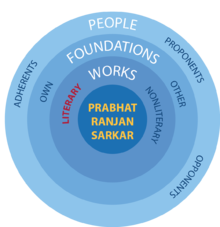User:Sharala/sandbox: Difference between revisions
No edit summary |
No edit summary |
||
| Line 16: | Line 16: | ||
== Synopsis == | == Synopsis == | ||
{{Quote box|width=360px|bgcolor=|align=left|quoted=1|salign=right|quote= | {{Quote box|width=360px|bgcolor=|align=left|quoted=1|salign=right|quote=Tathápi mama sarvasva Ráma kamalalocana.” | ||
So, all the propensities of the mind should be guided unto a singular entity with a singular name only using one’s own Iśt́a mantra and not any second mantra. That is why Hanumána says, “I always use the word Ráma and never Náráyańa. I don’t know who Náráyańa is.” | So, all the propensities of the mind should be guided unto a singular entity with a singular name only using one’s own Iśt́a mantra and not any second mantra. That is why Hanumána says, “I always use the word Ráma and never Náráyańa. I don’t know who Náráyańa is.” | ||
Revision as of 15:21, 28 April 2016
| Interpretation of “Ráma” and “Náráyańa” | |
|---|---|
| Speaker | Shrii Shrii Anandamurti |
| Date | 1978 September 25 |
| Place | Patna, India |
| Topic | One should use only his Ista mantra and no other mantra |
| Included in | Ananda Vacanamrtam Part 2 |
| Location in Sarkarverse | |
Interpretation of “Ráma” and “Náráyańa” is a discourse given by Shrii Shrii Anandamurti on 1978 September 25 in Patna, India. This discourse is the seventeenth chapter of Ananda Vacanamrtam Part 2.[1]
Synopsis
Tathápi mama sarvasva Ráma kamalalocana.”
So, all the propensities of the mind should be guided unto a singular entity with a singular name only using one’s own Iśt́a mantra and not any second mantra. That is why Hanumána says, “I always use the word Ráma and never Náráyańa. I don’t know who Náráyańa is.”
So every sádhaka should know that the only mantra in the universe is his Iśt́a mantra. He knows no other mantra.
Anandamurti starts the discourse by explaining the concept of dharana (a dynamic force of concentration within the mind) and its importance to the practice of mind withdrawal. He then explains that the mind's propensities have to be goaded towards the "citta" (objectivated i feeling), otherwise the misguided propensities will create an adverse effect on the mind. next, the citta will be guided towards the ahaḿtattva (the doer I) and the ahaḿtattva towards the mahattattva (pure i feeling). Anandamurti goes on explaining that to achieve a complete freedom from bondage, one has to withdraw all the mental propensities together with the citta, ahaḿtattva and mahattattva and merge them in the Supreme cognition. That last stage is the ultimate goal of human longing.[1]
References
| Preceded by Mind and Cognitive Faculty |
Ananda Vacanamrtam Part 2 1978 With: Pratyáhára Yoga and Paramágati |
Succeeded by Interpretation of “Ráma” and “Náráyańa” |
